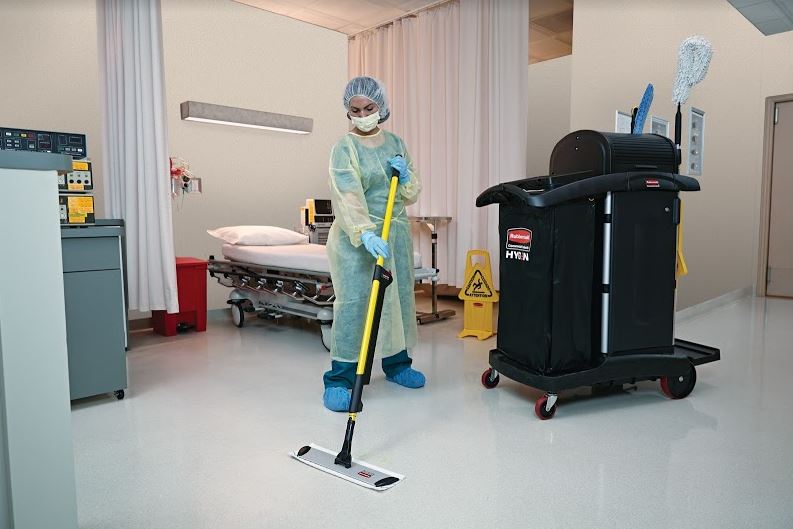
Hospital cleaning is the first line of defense against hospital acquired infections. Hospital staff and janitorial services should work together to maintain a clean environment, reducing the number of bacteria and other infectious agents present on all surfaces through effective cleaning and disinfection.
Hospital cleaning standards
There are three important factors that work together to help ensure high cleaning standards in a hospital or other healthcare facility and prevent the spread of infectious diseases. These are the agents used for cleaning, the equipment used for cleaning, and the techniques used for cleaning.
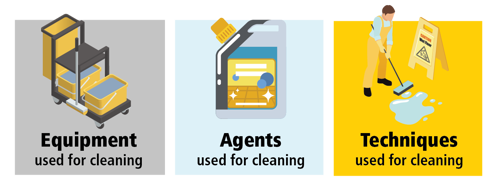
Cleaning chemicals or agents
Selecting the right cleaning agents is the first step to a correct hospital cleaning protocol. In some cases, water alone used with a specialized type of cleaning material may prove successful at creating a satisfactorily clean and safe surface. In other cases, a neutral detergent may be added to leverage the power of surfactants for deep cleaning.
Finally, for environments that require a higher level of decontamination, a chemical disinfectant may be required. Disinfectants should not be used as standalone cleaning agents. Rather, they should be included as ingredients in combination cleaning agents that also contain detergents or employed as part of a two-step process that includes cleaning first and disinfecting second.
Cleaning agents should be carefully chosen with an eye to efficacy and the types of surfaces to be cleaned. Walls and floors may require a different cleaning process than other hard surfaces, and equipment can be sensitive to certain chemical agents or liquids and require the selection of treated wipes or cloths instead.
Commercial cleaning agents mixed onsite by staff should be prepared carefully and in accordance with manufacturers' directions, and the required contact time for efficacy must be strictly observed. Certain types of cleaning chemicals require a rinsing step to be added to the process.
This is most common with cleaning agents that contain chlorine. After any cleaning process is complete, the surface should be wiped free of any pooled liquid and allowed to dry completely.
Cleaning solutions should be changed frequently to prevent cross-contamination to multiple surfaces being cleaned. When cleaning rooms where there is a high risk of transmission, solutions should be changed between each room. When cleaning up blood or other bodily fluids, used solutions should be discarded immediately. Solutions should also be changed as soon as there is visible discoloration or debris in the container.
Cleaning equipment
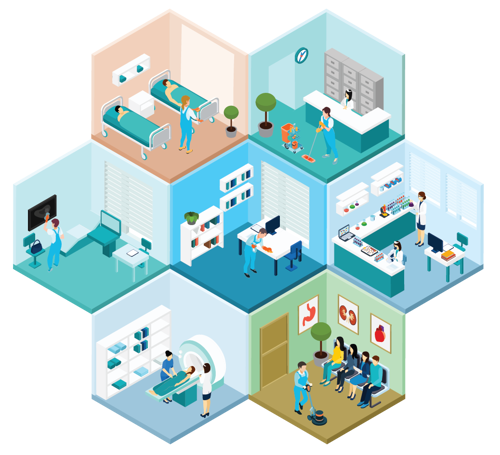
Cleaning equipment used in a hospital environment should be appropriate for use in a healthcare facility and designed for minimised contamination. Items like feather dusters and brooms are not appropriate, as they both generate and disperse dust. Vacuums must be fitted with high-efficiency particulate air (HEPA) filters which are changed regularly.
Use of spray bottles or aerosol chemicals in a hospital environment should be avoided; if the application of a chemical directly to a surface or cloth is desired, a squeeze bottle may be used to dispense detergents or disinfectants with minimal overdispersion.
Cleaning cloths and buckets containing cleaning solutions are the prime types of equipment used by staff to effectively clean rooms and other areas in a hospital environment. The type of cleaning cloth used may vary between different rooms and types of surfaces to be cleaned.
Some areas of the facility require less stringent disinfection than others, use less harsh chemical agents, and cause slower degradation of reusable cleaning cloths. Other areas require heavier cleaning with stronger cleaning solutions and will cause reusable cloths to degrade more quickly.
Disposable cleaning cloths may be required for "wet" areas or rooms with the highest risk of transmission. While not the first choice from a green outlook, the tradeoff may sometimes be necessary to reach a higher standard of decontamination.
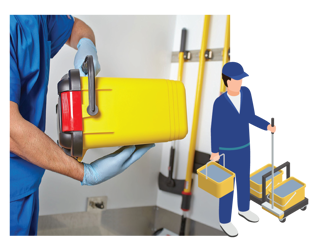
Reusable cleaning cloths require staff training in a cleaning system that ensures that clean cloths are used for each patient area, whether that be a single room, a shared room, or a bay. (single room, shared room, bay). Failure to do so could compromise the effectiveness of the cleaning process.
Microfibre cleaning cloths and mop heads utilize technology based on electrostatic attraction. Tiny charged fibres allow dirt particles to cling to the cloth. This technology makes it easier to effectively clean areas that are hard to reach, and the microfibre cloth material is strong and able to withstand repeated laundering.
All equipment used for hospital cleaning should be properly maintained, inspected regularly and changed by staff when required. Buckets and other containers should be checked for cracks before use, cleaned, disinfected, and allowed to dry between each use, and stored upside down.
All reusable cloths and mopheads should be changed and laundered once visibly soiled or after an area or room is cleaned. They should also be changed immediately if used to in an isolation room or to clean blood or body fluid spills (cloths contaminated in this fashion must be enclosed in an approved plastic bag for transport to the laundry.)
Cleaning techniques
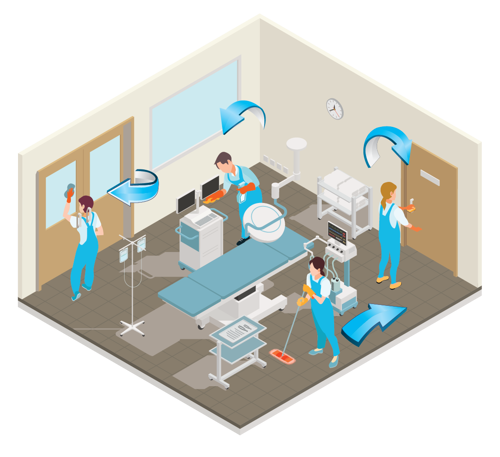
All cleaning services staff should be thoroughly trained on each type of cleaning agent, cleaning equipment, and cleaning technique used in the hospital facility. The requirement for cleaning standards adherence must be expressly outlined.
Incorrect or inappropriate techniques can lead to the transmission and spread of infectious diseases. To avoid risks, the use of agents, equipment, and technique must all be correctly implemented. Proper chemical solution mixing is not sufficient to sanitize if mopheads and buckets are dirty, or incorrect cleaning techniques are used.
The flow of cleaning is vital to maintain the cleanest environment possible. Cleaning should always progress from relatively clean areas to dirty ones. Low touch areas, surfaces, or elements should be cleaned first, and high touch ones (such as patient beds, the hand basin, and light switches or control knobs) last.
Likewise, the directional flow of cleaning should be from top to bottom and floors should be cleaned from the furthest part of the room to the door. Some adaptation may have to be made to ensure patient satisfaction in an occupied room, but any deviation should not impact the cleanliness of the room at the conclusion of the cleaning process.
Every effort should be made not to spread microorganisms via the cleaning process. Dusting should be done with damp cloths to minimise dust dispersion. Double-dipping a used cloth into a bucket that contains the clean solution and / or cloths can contaminate clean ones, and cause microorganisms to be spread to subsequent surfaces.
Proper cleaning techniques should include training on a clockwise or counterclockwise system, changing cloths and solution as needed. Cloths can be folded and rotated so each of eight quadrants can be used in turn, providing a fresh clean surface for multiple uses. More cloths may be required to clean high touch surfaces, or in areas with high transmission risk.
On completion of cleaning, each surface, element, and area should be checked to ensure standards have been upheld. Any elements showing signs of breakage that could compromise use or cleaning should be reported so they can be scheduled for maintenance or replacement.
Following these hospital cleaning practices can help to prevent infection and uphold the strict regulatory standards to which healthcare facilities are subject. For more information on cleaning equipment appropriate for healthcare use, visit our site.